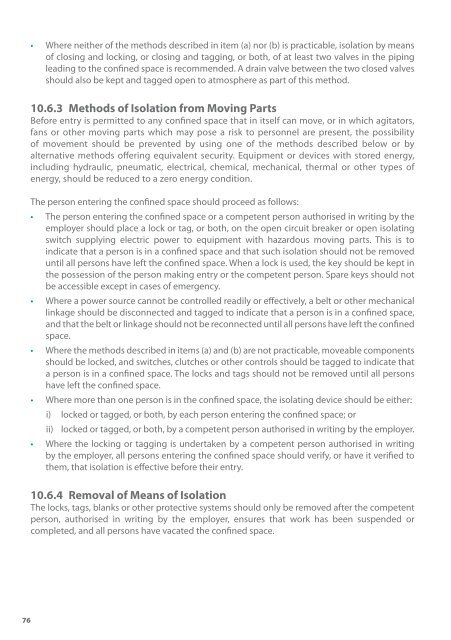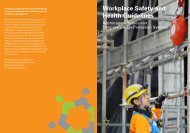Confined Spaces - Workplace Safety and Health Council
Confined Spaces - Workplace Safety and Health Council
Confined Spaces - Workplace Safety and Health Council
- No tags were found...
Create successful ePaper yourself
Turn your PDF publications into a flip-book with our unique Google optimized e-Paper software.
• Where neither of the methods described in item (a) nor (b) is practicable, isolation by meansof closing <strong>and</strong> locking, or closing <strong>and</strong> tagging, or both, of at least two valves in the pipingleading to the confined space is recommended. A drain valve between the two closed valvesshould also be kept <strong>and</strong> tagged open to atmosphere as part of this method.10.7 Annex 7: <strong>Confined</strong> Space Plan ChecklistCONFINED SPACE PLAN CHECKLIST10.6.3 Methods of Isolation from Moving PartsBefore entry is permitted to any confined space that in itself can move, or in which agitators,fans or other moving parts which may pose a risk to personnel are present, the possibilityof movement should be prevented by using one of the methods described below or byalternative methods offering equivalent security. Equipment or devices with stored energy,including hydraulic, pneumatic, electrical, chemical, mechanical, thermal or other types ofenergy, should be reduced to a zero energy condition.The person entering the confined space should proceed as follows:• The person entering the confined space or a competent person authorised in writing by theemployer should place a lock or tag, or both, on the open circuit breaker or open isolatingswitch supplying electric power to equipment with hazardous moving parts. This is toindicate that a person is in a confined space <strong>and</strong> that such isolation should not be removeduntil all persons have left the confined space. When a lock is used, the key should be kept inthe possession of the person making entry or the competent person. Spare keys should notbe accessible except in cases of emergency.• Where a power source cannot be controlled readily or effectively, a belt or other mechanicallinkage should be disconnected <strong>and</strong> tagged to indicate that a person is in a confined space,<strong>and</strong> that the belt or linkage should not be reconnected until all persons have left the confinedspace.• Where the methods described in items (a) <strong>and</strong> (b) are not practicable, moveable componentsshould be locked, <strong>and</strong> switches, clutches or other controls should be tagged to indicate thata person is in a confined space. The locks <strong>and</strong> tags should not be removed until all personshave left the confined space.• Where more than one person is in the confined space, the isolating device should be either:i) locked or tagged, or both, by each person entering the confined space; orii) locked or tagged, or both, by a competent person authorised in writing by the employer.• Where the locking or tagging is undertaken by a competent person authorised in writingby the employer, all persons entering the confined space should verify, or have it verified tothem, that isolation is effective before their entry.10.6.4 Removal of Means of IsolationThe locks, tags, blanks or other protective systems should only be removed after the competentperson, authorised in writing by the employer, ensures that work has been suspended orcompleted, <strong>and</strong> all persons have vacated the confined space.<strong>Workplace</strong> Name:<strong>Workplace</strong> No:Elements of <strong>Confined</strong> Space Plan1. Responsibilities of Personneli) Have the following key personnel who are involved inconfined space entry or work been appointed?• Authorised Manager• <strong>Confined</strong> Space <strong>Safety</strong> Assessor• <strong>Confined</strong> Space Attendant• Rescue Personnelii) Are the duties <strong>and</strong> responsibilities of all employees(including key personnel) clearly stipulated?2. <strong>Confined</strong> Space Identificationi) Have you identified all the confined spaces within yourworkplace?ii) Do you keep a record of all identified confined spaces?ii) Have all affected employees been informed of theexistence of these confined spaces <strong>and</strong> warned of thepossible hazards?3. Risk Assessmenti) Have all confined space entry or work been evaluatedto assess the necessity of conducting such work withinthe workplace?ii) Has a risk assessment been conducted to identify,evaluate <strong>and</strong> control all risks arising from entry or workin confined spaces?iii) Are the risk control measures selected based on thehierarchy of control for management of confined spacehazards?iv) Are confined space hazards re-evaluated when newoperations or work procedures are introduced or whencurrent operations or work procedures are altered?4. Safe Work Procedures & <strong>Confined</strong> Space Entry Permiti) Have safe work procedures been established for allconfined space works?Date:ReferenceDocumentName & No76 77ii) Do the safe work procedures for confined space coverYesNo
















